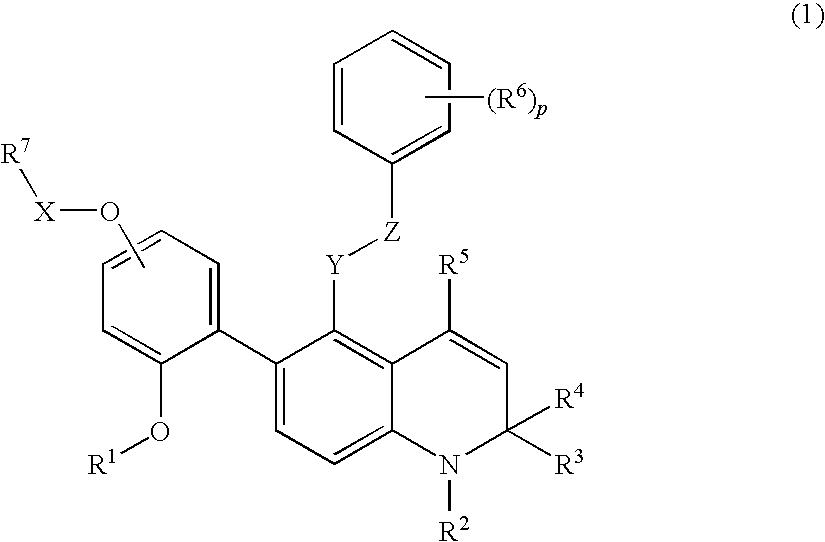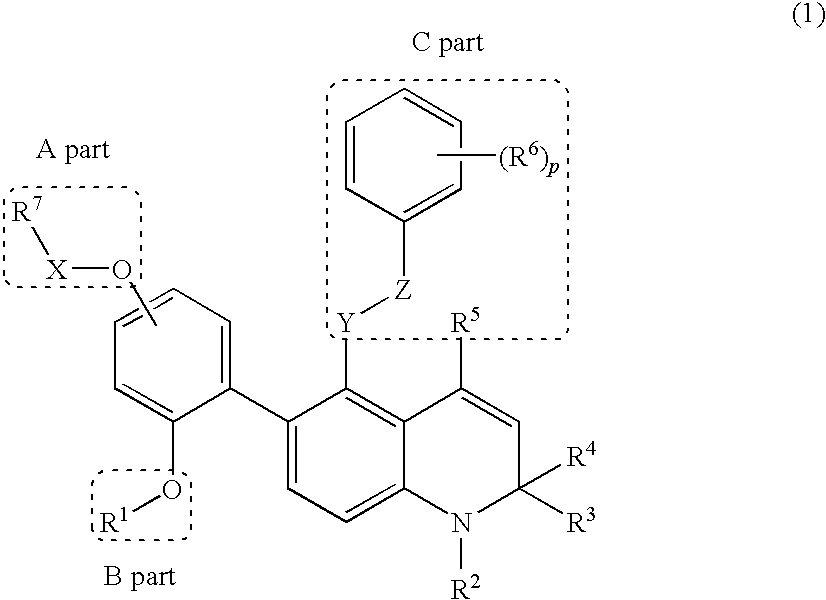Novel 1,2-dihydroquinoline derivative having substituted phenylchalcogeno lower alkyl group and ester- introduced phenyl group as substituents
a technology of phenylchalcogeno and ester, which is applied in the field of 1,2-dihydroquinoline derivatives having substituted phenylchalcogeno lower alkyl group and esterintroduced phenyl group as substituents, can solve the problems of 1,2-dihydroquinoline derivatives and the substitutions have not been specifically disclosed, and achieve excellent glucocorticoid receptor binding activity and useful as a glucocortico
- Summary
- Abstract
- Description
- Claims
- Application Information
AI Technical Summary
Benefits of technology
Problems solved by technology
Method used
Image
Examples
production examples
Reference Example 1
5-Hydroxymethyl-6-(2-methoxy-4-methoxymethoxyphenyl)-2,2,4-trimethyl-1,2-dihydroquinoline
Reference Compound No. 1-1
Methyl 2-(2,4-dimethoxyphenyl)-5-nitrobenzoate
Reference Compound No. 1-1-(1)
[0251]A mixture of 2,4-dimethoxyphenylboronic acid (25.0 g, 137 mmol), methyl 2-bromo-5-nitrobenzoate (35.7 g, 137 mmol), cesium carbonate (89.4 g, 274 mmol) and bis(triphenylphosphine)palladium (II) dichloride (4.81 g, 6.85 mmol) was suspended in N,N-dimethylformamide (450 mL), and then the suspension was stirred under argon atmosphere at 80° C. overnight. After cooling down, ethyl acetate (200 mL), diethylether (400 mL) and water (1000 mL) were added thereto and the mixture was separated into a water phase and an organic layer. The water layer was extracted with a mixed solvent of ethyl acetate (150 mL)-diethylether (150 mL) (twice). The combined organic layer was washed with water (500 mL, 3 times) and saturated brine (500 mL) successively, dried over anhydrous magnesium su...
reference example 2
5-(5-Fluoro-2-methylphenoxymethyl)-6-(2-methoxy-4-methoxymethoxyphenyl)-2,2,4-trimethyl-1,2-dihydroquinoline
Reference Compound No. 2-1
[0258]5-Hydroxymethyl-6-(2-methoxy-4-methoxymethoxyphenyl)-2,2,4-trimethyl-1,2-dihydroquinoline (Reference Compound No. 1-1, 511.7 mg, 1.39 mmol), 5-fluoro-2-methylphenol (182 μL, 1.67 mmol), tri-n-butylphosphine (521 μL, 2.09 mmol), and 1,1′-(azodicarbonyl)dipiperidine (526 mg, 2.08 mmol) were dissolved in anhydrous benzene (8 mL), and then the mixture was stirred under argon atmosphere at room temperature for hour. Hexane (15 mL) was added to the reaction mixture, and the unsoluble materials were filtered out. The filtrate was concentrated under reduced pressure and the residue was purified by silica gel column chromatography (hexane-ethyl acetate) to give the titled reference compound (411.4 mg) as a colorless amorphous product. (Yield 62%)
1H-NMR (400 MHz, DMSO-d6) δ 1.13 (s, 3H), 1.20 (s, 3H), 2.23 (s, 3H), 3.41 (s, 3H), 3.65 (s, 3H), 4.14 (d, J =...
reference example 3
5-(5-Fluoro-2-methylphenoxymethyl)-6-(4-hydroxy-2-methoxyphenyl)-2,2,4-trimethyl-1,2-dihydroquinoline
Reference Compound No. 3-1
[0259]5-(5-Fluoro-2-methylphenoxymethyl)-6-(2-methoxy-4-methoxymethoxyphenyl)-2,2,4-trimethyl-1,2-dihydroquinoline (Reference Compound No. 2-1, 424 mg, 0.888 mmol) was dissolved in 1,4-dioxane (5 mL), 4N HCl / 1,4-dioxane solution (666 μL) was added thereto, and then the mixture was stirred at room temperature overnight. The mixture was diluted with ethyl acetate (150 mL). The mixture was washed with water (100 mL, twice) and saturated brine (50 mL) successively, dried over anhydrous magnesium sulfate, and then the solvent was removed under reduced pressure. The obtained residue was purified by silica gel column chromatography (hexane-ethyl acetate) to give the titled reference compound (241.7 mg) as a colorless solid. (Yield 63%)
1H-NMR (400 MHz, DMSO-d6) δ 1.00 (s, 3H), 1.14 (s, 3H), 2.01 (s, 3H), 2.08 (s, 3H), 3.67 (s, 3H), 4.63 (d, J = 12.1 Hz, 1H), 5.08 (d...
PUM
| Property | Measurement | Unit |
|---|---|---|
| temperature | aaaaa | aaaaa |
| temperature | aaaaa | aaaaa |
| temperature | aaaaa | aaaaa |
Abstract
Description
Claims
Application Information
 Login to View More
Login to View More - R&D
- Intellectual Property
- Life Sciences
- Materials
- Tech Scout
- Unparalleled Data Quality
- Higher Quality Content
- 60% Fewer Hallucinations
Browse by: Latest US Patents, China's latest patents, Technical Efficacy Thesaurus, Application Domain, Technology Topic, Popular Technical Reports.
© 2025 PatSnap. All rights reserved.Legal|Privacy policy|Modern Slavery Act Transparency Statement|Sitemap|About US| Contact US: help@patsnap.com



